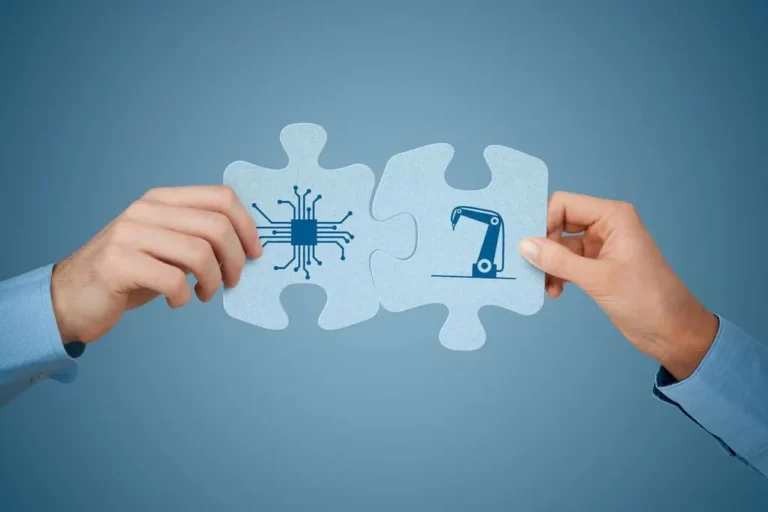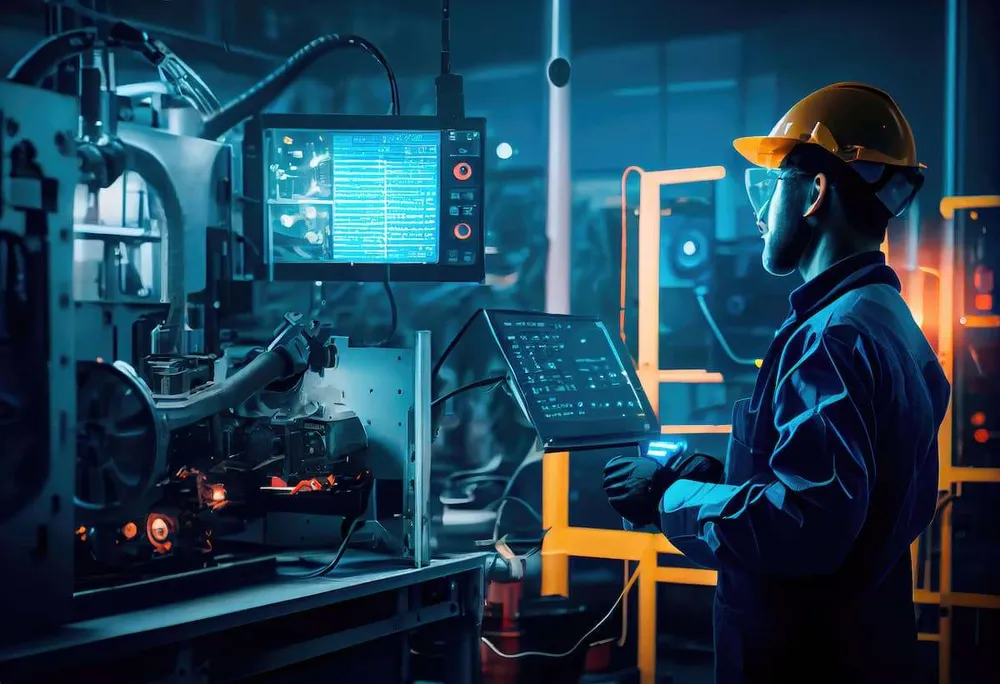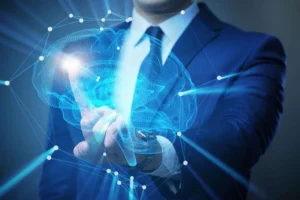AI Robotics: Understanding AI’s Impact on the Field

The robotics industry is currently undergoing transformation. Today, approximately 3 million robots power various sectors around the world. Almost 500,000 new machines join them every year. Automotive, electronics, manufacturing, and arms — all these industries use automated systems powered by the latest AI tech.
AI robotics represents an advanced ecosystem where elements like computer vision, smart programming, and augmented learning empower machines to make decisions akin to humans. Today, let’s delve into how modern technology is shaping the robotics industry.
What is AI Robotics, and Why Is It Important
AI robotics is the integration of intelligence into machines to get more automation. The integration of AI has propelled the AI robotics market to impressive heights. The market is valued at US $6.9 billion in 2021 and is projected to reach US $35.5 billion by 2026. It demonstrates a compound annual growth rate (CAGR) of 38.6%. Moreover, AI robots won’t steal jobs; they’ll improve them. Humans will be freed from mundane tasks, allowing them to focus on creative problem-solving and tasks requiring social intelligence — areas where AI still lags behind.
To fully capture the powers of AI-fueled machines and automated service agents, it’s crucial to understand what constitutes their intelligence. AI covers a wide array of systems that empower machines to mimic complex human abilities. It lays the groundwork for a future where robots are no longer simply programmed processors but intelligent entities that are able to learn, adapt, and operate autonomously.
AI-driven robots are supplied with a multitude of sensors (thermometers, cameras, vibration detectors, proximity sensors, etc.). The machines can process and react to the information from their sensors instantly.
The foundations of AI integration are natural language processing (NLP) and automated machine learning. Thanks to technology, robots can model scenarios and train from people’s behavior to do specific jobs. In essence, the tech gives robots a kind of computer vision; it enables them to observe, navigate, and modify actions in response to their surroundings.
Moreover, edge computing is essential to this cooperation. Real-time analysis of vast sets of information produced by sensors is a must for AI applications in this industry. The tech processes data locally on the system instead of transferring it to the cloud. Such a localized method gives robots situational awareness in real time.
The importance of AI robotics stems from the positive interplay between these two fields. First, AI surpasses basic pre-programmed duties for robots. Their ability to learn and make decisions will provide more accurate automation in all industries. Additionally, AI-driven robots can do physically demanding or dangerous work – they protect workers and free them up to focus on higher-order cognitive processes.

We are confident that we have what it takes to help you get your platform from the idea throughout design and development phases, all the way to successful deployment in a production environment!
How AI is Changing Robotics?
Robots that are constantly developing and improving their skills are becoming a reality. Today, intelligent robots can handle an array of task, so let’s look at them:
- extract insights from data;
- arrive at decisions, relying on available knowledge;
- autonomously navigate complicated settings;
- perform activities with advanced precision and skill;
- efficiently collaborate and complement your team’s efforts.
Now, businesses are waiting for one-of-a-kind applications that might shake up industries and radically change the nature of work.
Extended capabilities
AI robots are able to make decisions based on complex modeling and real-world information. Their algorithms are powerful data analyzers that process multiple inputs to understand the environment. They make predictions about possible future events and ultimately build an optimal plan of action that allows the robot to achieve its goals.
ML helps here as well. With it, robots may learn from data and adjust to constantly changing situations. Advanced algorithms let robots continuously enhance their performance. This increases their adaptability and efficacy across various applications as they spot trends and offer predictions.
As data sponges, machines driven by ML algorithms take in extensive sets of information from various sensors. They comprehend their environment and engage with people productively. Ultimately, they show success in analyzing photos, videos, sensor information, and even human input to spot trends and patterns that would be incomprehensible to people.
The powerful combination of AI and ML helps robots do ever more complex jobs, such as:
- Spot and interact with objects in their environment;
- Maneuver through challenging conditions, avoid dangers with ease, and swiftly adapt to abrupt changes without the need for human support;
- Securely and successfully work in tandem with others, exchange info, and cooperate on projects.
Finally, robotics development allows them to foresee and prevent equipment malfunctions. Because they are constantly evolving, they don’t require ongoing assistance.

Autonomous pathfinding and preventive measures
Machines gather data about their surroundings through sensors and cameras. Algorithms continuously check the map and produce the best possible routes for the robot.
It is a continuing, dynamic process. Robots constantly collect fresh data from sensors while they move. They put it back into the model to keep their perception of the surroundings up to date. This lets them respond and adjust to changes instantly. The result? Safe and easy travel.
Additionally, in the automotive industry, machine learning and robotics algorithms evaluate sensor information to differentiate between dynamic impediments like moving cars or humans and static obstacles. With barrier detection, the algorithms can provide avoidance tactics — adjusting the robot’s course, reducing speed, or even stopping entirely to prevent collisions.
Identification and modification of objects
Object recognition is the foundation of a robot’s capacity to see and recognize items in its surroundings. ML algorithms that carefully scrutinize sensor data carry out such work. Complex algorithms create a digital fingerprint of each item and extract crucial attributes (form, color, texture, and spatial arrangement).
Equipped with full information, the algorithms compare it with an extensive library of recognized items and objects. This makes it possible for robots to precisely identify and classify items according to their distinctive qualities. Robots may constantly add to their knowledge base when they come across new items or variants of ones they already know. Ultimately, it helps them to amp up their recognition models for brand-new experiences in the long run.
However, identifying objects is not the only ability. Robots can also meaningfully manipulate them. So what do they do? First, they can grasp, manage, and even construct objects. Algorithms determine the best tactics based on the position and shape of objects. In addition, the system takes into account object fragility and surface quality to ensure safe handling.
ML algorithms take the reins — they meticulously plan and run the robot’s motions to manipulate it. Such an intricate setup involves synchronizing the robot’s parts. The primary purpose is to offer accurate and controlled motions.
Real-World Applications and Examples
The transformative power of modern tech is rippling through diverse sectors. Some industries reap particularly significant benefits:
- Transportation. The transportation landscape is undergoing a transformative shift, with intelligent solutions like traffic management systems, autonomous vehicles, and optimized logistical planning already in play. Sophisticated algorithms evaluate sensor data, road situations, and traffic dynamics to make critical decisions that optimize network efficiency. A prime illustration are self-driving cars, capable of near-human intelligence. Such vehicles can navigate highways, maneuver around obstacles, and make informed judgments, revolutionizing the future of mobility.
- Hospitality. Robots like United Robotics Group’s PLATO are made to handle jobs like cleaning, food service, and welcome. With the use of AI, these robots improve consumer satisfaction while reducing labor costs.
- Farming. The agricultural sector embraces robotic advancements to automate crop planting, harvesting, and fertilization. This shift reduces labor costs and significantly amps up workflow and effectiveness. Consequently, crop yields are demonstrably raised, while the overall quality of the produce is elevated considerably.
- Healthcare. The combination of robotics and artificial intelligence holds immense potential for improvements in healthcare. Surgical robots, for instance, offer enhanced precision and accuracy during minimally invasive procedures, leading to lowered complications and faster patient recovery times. Additionally, AI algorithms are increasingly used to interpret medical info (patient records and diagnostic images) to aid in diagnostics and treatment plans.
- Manufacturing. Predictive maintenance and automated robotic control systems redefine manufacturing. These advancements leverage sensor data embedded within equipment to anticipate possible breakdowns before they happen. This proactive approach minimizes downtime and significantly boosts overall production efficiency. A prime example of this is the rise of AI-powered predictive maintenance systems. They actively analyze equipment performance, addressing the malfunctions before they escalate into costly breakdowns.
Robots can perform challenging jobs, adjust to changing surroundings, and work in collaboration with robotics engineers. We anticipate seeing them in an increasing number of businesses, performing various jobs, and interacting with people in nonstandard and creative ways.
Final Words
Robotics has a bright future ahead of them. It’s full of possibilities to elevate the quality of life and find robotics solutions for challenging issues. Modern businesses combine the computational power of AI with the physical powers of robotics. That way, they open up previously unimaginable possibilities for R&D. Thanks to synergistic achievement, the dream of Artificial General Intelligence (AGI) is becoming closer.
With AI technologies, robots are becoming smarter, more capable, and more adaptable than ever before. With the potential and expertise of the Global Cloud Team, you can implement the latest trends in artificial intelligence in your business. Whether transforming manufacturing with complex robotics or streamlining logistics with advanced portals, our team of specialists has enough skills to create AI-powered solutions catering to your needs. Contact us today to spruce up your firm with our state-of-the-art technologies.
Top Articles
Digital Transformation in Customer Service: A Comprehensive Overview
I am here to help you!
Explore the possibility to hire a dedicated R&D team that helps your company to scale product development.






